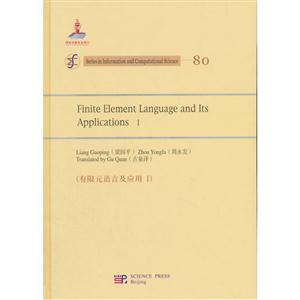Finite Element Language and Its Applications I-(有限元语言及应用 I)
本书特色
[
有限元语言是一种适用于有限元方法求解偏微分 方程的模型语言。采用有限元语言编程就是书写偏微 分方程和算法,然后由生成器产生全部fortran语言 的有限元程序。梁国平、周永发编*的《有限元语言 及应用(ⅰ英文版)(精)》的主要内容包括微分方程表 达式,单物理场算法和多场耦合有限元算法的描述语 言;元件化程序设计方法;有限元的数据结构;形函 数库,微分算子库,单物理算法库等。
]
目录
preface to the series in information and computational scienceprefaceintroductionchapter 1 description language of differential equation expression 1.1 writing pde files 1.1.1 defi information segments 1.1.2 func information segments 1.1.3 stif information segments 1.1.4 mass information segments 1.1.5 damp information segments 1.1.6 load information segments 1.1.7 insert fortran source programs 1.1.8 examples 1.2 writing cde files 1.2.1 defi information segments 1.2.2 func information segments 1.2.3 shif information segments 1.2.4 mass information segments 1.2.5 damp information segment 1.2.6 load information segments 1.2.7 insert fortran source programs 1.2.8 examples 1.3 writing vde files 1.3.1 vector and matrix specification statements 1.3.2 array specification statements 1.3.3 tensor operation expressions 1.3.4 examples 1.4 writing fde files 1.4.1 writing format of fde documents 1.4.2 fvect and fmatr statements 1.4.3 l operator statements 1.4.4 common l operator library 1.4.5 a operator statements 1.4.6 w operator statements 1.4.7 s operator statements 1.4.8 r operator statements 1.4.9 examples 1.5 writing fbc files 1.6 writing ges files 1.6.1 ges files structure 1.6.2 rules for writing ges files 1.6.3 examples 1.6.4 element subroutine 1.7 writing glt files 1.7.1 defi information segments 1.7.2 vart information segments 1.7.3 insert fortran source programs 1.8 writing finite volume method programs 1.8.1 gvs file structure 1.8.2 rules for writing gvs files 1.8.3 rules for writing fvs files 1.8.4 basic flow of finite volume method program 1.8.5 examples 1.8.6 fvs files of several types of elementschapter 2 description language of algorithms in single-physics fields 2.1 nfe file structure 2.2 rules of writing nfe files 2.2.1 defi information segments 2.2.2 coef information segments 2.2.3 equation information segments 2.2.4 solution information segments 2.2.5 insert fortran source programs 2.2.6 the ending character 2.3 nfe algorithm library 2.3.1 ell. nfe 2.3.2 nell. nfe 2.3.3 parb. nfe 2.3.4 par. ale 2.3.5 nparb, nfe 2.3.6 npar. nfe 2.3.7 wave. nfe 2.3.8 wavev. nfe 2.3.9 newmark. nfe 2.3.10 waveexp. nfe 2.3.11 nwave, nfe 2.3.12 nnewmark. nfe 2.3.13 nwaveexp. nfe 2.3.14 str. nfe 2.3.15 nstr. nfe 2.3.16 hypls, nfe 2.3.17 cbsexp, nfechapter 3 description language of coupling fem algorithms in multi-physlcs fields 3.1 writing gcn files 3.1.1 writing pattern 3.1.2 examples 3.2 gcn library 3.3 writing mdi files 3.3.1 writing pattern 3.3.2 exampleschapter 4 component-based program design method 4.1 finite element program structure and component-based program design method 4.1.1 program structure 4.1.2 component-based program design method 4.2 five component programs 4.2.1 start component program 4.2.2 bft component program 4.2.3 e component program 4.2.4 solv solver 4.2.5 u component programchapter 5 data structure of finite element method 5.1 component description of input data for finite element computation 5.1.1 data entry form 5.1.2 read/write format of table files 5.2 input data of fem in single-physics problem 5.2.1 coordinate data table 5.2.2 table of node specification number 5.2.3 table of specified nodal displacement and nodal load information 5.2.4 table of initial values 5.2.5 element information data 5.3 display and query of fem input data 5.4 pre files 5.4.1 linear steady state examples 5.4.2 nonlinear transient examples 5.4.3 examples of coupling problems in multi-physics fields ~ 5.4.4 automatic writing and modification of files 5.5 results display pos filesappendix a interpolation functions and element types a.1 1d lagrange element a.1.1 1d linear element a.1.2 1d quadratic element a.2 2d lag-range element a.2.1 four nodal rectangular element a.2.2 nine-node rectangular element a.2.3 eight nodal rectangular element a.2.4 three nodal triangle element a.2.5 six triangle element a.3 3d lagrange element a.3.1 eight-node hexahedral element a.3.2 27-node hexahedral element a.3.3 20-node hexahedral element a.3.4 four nodal tetrahedron element a.3.5 ten-node tetrahedron element a.3.6 six-node triangular prism elementappendix b isoparametric element b.1 integral transformation for rectangular coordinates of natural coordinates b.2 integral transformation for rectangular coordinates of natural coordinatesappendix c numerical integration c.1 gaussian integral c.2 nodal integralappendix d appendix d term collections of finite element programappendix e collections of key words of finite element languagesymbol tablereferencesindex
封面

书名:Finite Element Language and Its Applications I-(有限元语言及应用 I)
作者:梁国平
页数:264
定价:¥108.0
出版社:科学出版社
出版日期:2016-01-01
ISBN:9787030465177
PDF电子书大小:53MB 高清扫描完整版
